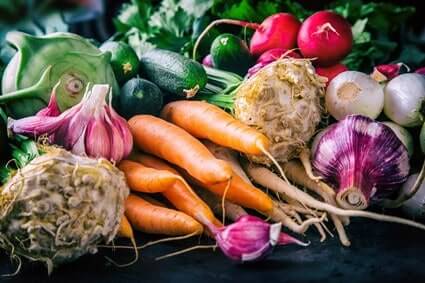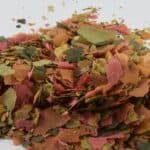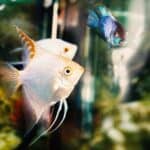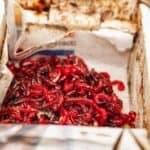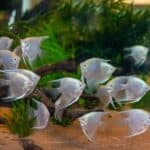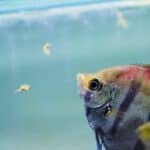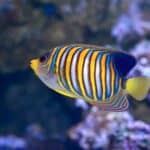Angelfish have specific dietary requirements. Alongside their daily pellets and flakes, they need a diet of live foods, fruits, and vegetables.
Angelfish can eat cucumber, zucchini, lettuce, spinach, broccoli, carrots, and wild vegetables.
The healthiest vegetable for angelfish is peas, as they can ease the symptoms of constipation while flushing out their digestive system.
When feeding angelfish vegetables, blanch or boil them first. Never give them frozen vegetables because this can cause constipation.
As well as vitamins and minerals, vegetables provide angelfish with mental stimulation. They’re also a good source of fiber, which angelfish need for healthy digestion and gut health.
Can I Feed My Angelfish Vegetables?
Angelfish are omnivores, so they eat meat and plants. While their diet should comprise quality pellets or flakes with protein, they can eat vegetables as a treat.
Wild angelfish eat plants found in the rivers they live in. This allows them to increase their vitamin and mineral intake. It’s hard to get these native plants, so some vegetables are a healthy substitution.
As mentioned, vegetables are also high in fiber, which keeps your angelfish’s digestive system working efficiently, preventing constipation.
However, not all angelfish enjoy the taste and texture of all the vegetables you feed them, so some trial and error will be required until you find the veggie varieties they want.
Also, as described by the Journal of Applied Biological Sciences, angelfish need high protein levels to stay healthy. Vegetables are high in carbohydrates, so they should only make up a small part of their diet.
How Often Can I Feed My Angelfish Vegetables?
If you feed veggies too often, your fish will fill up on these high-carb foods and miss out on the protein and amino acids they need. According to the MSD Veterinary Manual, too many carbs can lead to fatty liver disease.
That’s why you shouldn’t give your angelfish vegetables every day. Instead, restrict them to a tasty treat a couple of times a week, being careful not to overfeed. As a rule of thumb, feed your angelfish enough vegetables that they can eat in two minutes or less.
How To Feed Vegetables To Angelfish
Before giving veggies to your angelfish, make sure they’re adequately prepared first. To do so:
- Boil all vegetables until they’re soft.
- Cut them into the smallest pieces, allowing your angelfish to scoop them up with their mouths.
- Offer only a small amount of vegetables at one time.
If the angelfish don’t eat all the vegetables in one go, feed them less the next time. Similarly, remove uneaten vegetables from the tank after 5 minutes to keep the conditions sanitary.
You’ll also need to wash all vegetables before giving them to your angelfish. Store-bought veggies are usually covered in dirt, bacteria, pesticides, and harmful chemicals, especially if they’re not organic.
Run the vegetables until water and scrub them with a stiff brush to get all harmful residues off the skin.
Can I Feed My Angelfish Frozen Vegetables?
While you can buy frozen vegetables or freeze the fresh ones you have before they go out of date, you should let them thaw before you feed them to your angelfish.
If you don’t, they may struggle to eat them. Frozen vegetables are more likely to cause impaction.
If you have fed your angelfish frozen vegetables because you haven’t realized they can be harmful, look out for these signs of impaction:
- A noticeably swollen belly.
- Sudden loss of appetite.
- Spitting out food.
- Raised scales.
- Stringy feces.
- Lethargy.
- Refusal to swim.
Constipation is a severe problem if it’s not treated.
To do so, stop feeding your angelfish frozen vegetables and add Epsom salt to the tank. This is a mild muscle relaxant that can help your fish go to the toilet more regularly.
You can also keep feeding your fish fresh, boiled vegetables, as they’re high in fiber and can’t enable the digestive system to work correctly again.
In particular, peas can help ease the symptoms of constipation.
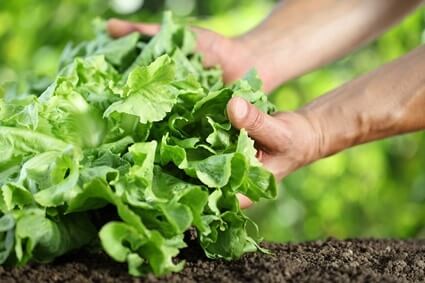
Can Vegetables Cause Tank Problems?
Unfortunately, uneaten vegetables aren’t suitable for your tank’s conditions because they quickly decompose underwater, releasing ammonia and nitrites as they rot. This is especially dangerous in new tanks, as the beneficial bacteria won’t have the chance to develop fully.
Ammonia and nitrites are fatal in high doses, as they poison fish, making them unwell. If you don’t deal with the problem quickly enough, your fish will die.
The decomposition process also uses a fair amount of oxygen, lowering the tank’s overall dissolved oxygen content.
In warm angelfish tanks that are kept between 75 to 80 degrees Fahrenheit, the situation’s even more severe because dissolved oxygen decreases at warmer temperatures.
Uneaten vegetables can also clog your filter, preventing it from working effectively. The result of this could potentially include:
- Low dissolved oxygen content.
- Unstable pH levels.
- A rise in ammonia and nitrites.
- Reduced circulation.
- Increased mold and fungus growth.
Remove all uneaten vegetables 5 minutes after you’ve placed them into your tank. If the angelfish haven’t eaten them, they’re unlikely to do so before the food decays.
Can Angelfish Eat Broccoli?
Broccoli is safe for angelfish to eat, as long as it’s finely chopped and boiled or blanched first.
Broccoli can be fibrous, so you should aim to soften it as much as possible before putting it into the tank. Broccoli is an excellent source of protein and fiber. It also contains:
- Iron.
- Potassium.
- Calcium.
- Selenium.
- Magnesium.
- Folic acid.
- Vitamins A, C, E, K.
According to the Animal Science Database, selenium protects angelfish cell membranes and tissues against oxidative damage.
It also helps angelfish grow and develop while keeping their skin and scale quality healthy.
Without selenium, fish are at risk of stunted growth, impaired reproduction, anemia, and death.
Because broccoli is quite large, it’s easy to overfeed angelfish. They only have small stomachs, so you only need to give them the tiniest pieces of broccoli. A whole floret is far too much.
Can Angelfish Eat Carrots?
If carrots aren’t boiled beforehand, they’re far too tricky for angelfish to eat. Once softened, slice them as thin as possible to encourage your angelfish to eat the carrots.
Canned carrots aren’t suitable, as they may come with added preservatives that your angelfish shouldn’t eat. That’s why fresh or frozen carrots are best.
Fresh, boiled carrots free from chemical residue are rich in antioxidants and provide essential minerals, vitamins, and fiber. These nutrients protect against infection and maintain healthy skin and scales.
The leafy part of the carrots is also healthy and can be given to your angelfish at the same time as the carrot pieces. Angelfish love plant matter, so they’ll eat it up with relish.
Can Angelfish Eat Cucumber?
Cucumbers are among the most readily-accepted vegetables, as most angelfish enjoy the watery taste and soft texture. However, angelfish will struggle to chew on cucumber if the pieces are too big. Therefore, cut it into tiny chunks to make it easier for your angelfish to eat.
Most of a cucumber’s health benefits are contained within the skin. That’s because there’s plenty of fiber, so don’t peel the skin off before giving it to your angelfish. Cucumber also contains:
- Vitamin C and K.
- Magnesium.
- Potassium.
- Manganese.
Magnesium is one of the most essential nutrients for fish. It supports a healthy immune system and keeps the muscles functioning properly.
If you’re wondering how to feed cucumber to angelfish, it’s a straightforward process. Wash the cucumber’s skin and cut it into small chunks that your fish can feast on.
Angelfish won’t eat the seeds, so remove them before putting the cucumber into the tank. If you don’t, they’ll become waste matter that could taint the tank’s water conditions.
Can Angelfish Eat Lettuce?
Lettuce is soft and easy to eat, so angelfish enjoy picking at the leaves. While red leaf lettuce is easier for them to chew, they’ll eat all kinds, including iceberg and romaine.
However, lettuce is one of the worst vegetables for harboring pesticides, so you must wash it thoroughly first. Otherwise, it can cause the tank’s water conditions to deteriorate.
To be on the safe side, choose organic lettuce. Like many other vegetables, lettuce contains:
- Vitamin A, C, and K.
- Calcium.
- Fiber.
These nutrients all play an essential part in keeping your angelfish healthy. Calcium, in particular, is vital for bone development.
However, these nutrients are only found in trace amounts, so lettuce isn’t the most nutritionally dense food available.
That being said, because lettuce is a preferred vegetable for many angelfish, it can pave the to introduce new vegetables to your fish. Once they know they enjoy lettuce, they might feel more comfortable trying alternative veggies.
Can Angelfish Eat Peas?
Green peas are one of the healthiest vegetables for angelfish to eat. However, not all are suitable.

For example, like carrots, canned peas are packed with preservatives and additives that keep them on grocery shelves longer. That’s why canned peas have an unusually long shelf life. These chemicals may harm your fish.
Similarly, snap peas commonly have higher pesticide residues than other varieties. The healthiest kind is frozen organic peas. Though, you must cook them first. Peas contain:
- Vitamin A and C.
- Calcium.
- Iron.
Angelfish requires these vitamins and minerals for strong, healthy bones. They also help improve digestion and protect against diseases.
Freshly boiled peas can also help with bloating and constipation. That’s because they’re higher in fiber than other vegetables, which can help flush out the fish’s system.
They can also help ease the symptoms of dropsy, which is where fluid builds up in the body’s tissue.
It’s caused by bacteria, and affected fish will have swollen bellies. However, fish are only susceptible when their immune systems are compromised.
Providing a healthy, varied diet that consists of high-quality foods, such as peas, may help treat the condition if it’s not already too advanced.
However, feeding peas to angelfish isn’t easy because they don’t always know what to do with them. To help resolve this, put them on a fast the day before to make them hungry enough to eat them.
Then, boil them until they’re soft and mushy, and remove as much of the outer shell as possible to make them easier for angelfish to eat.
Can Angelfish Eat Spinach?
Spinach is a good source of plant-based protein, which angelfish need. It’s also one of the most nutritious vegetables, making it a good option for the angelfish. As well as protein, spinach is a source of:
- Vitamin A, B2, C, and K.
- Folate.
- Magnesium.
- Manganese.
- Iron.
- Calcium.
However, while spinach is packed with healthy goodness, it’s also high in oxalate. This is a chemical compound that prevents the body from absorbing calcium.
Similarly, iron and oxalate hinder nutrient absorption when they’re consumed together.
Even though spinach is healthy, you must be careful with how much you give to your angelfish.
Incorporating only small amounts of spinach into the angelfish’s weekly vegetable allowance is a great way to keep your angelfish’s vitamin and nutrient levels optimized.
Fresh spinach is suitable, but be wary of some frozen varieties, as they contain salt and other additives. Check the ingredients list properly to ensure the spinach suits the angelfish.
Can Angelfish Eat Wild Vegetables?
Wild vegetables include dandelion greens, chicory, and dock. Angelfish enjoy eating all kinds of plants and leaves, so adding these foods to your fish’s feeding schedule can provide them with all-important mental stimulation.
Meanwhile, angelfish may leave aquarium plants alone, preferring to hide amongst them. Wild leaves can redirect their attention if the tank’s fauna and flora tempt them.
However, wild vegetables and leaves run a more significant risk of pesticides than all other veggies, depending on where you source them.
Instead of only running them under the tap, leave the leaves to soak in cool water for a little while. Rinse them thoroughly afterward to remove any chemical residue.
Can Angelfish Eat Zucchini?
Alongside cucumber, zucchini is another widely accepted vegetable by plant-eating fish, including angelfish. Zucchini contains:
- Vitamins A, C, and K.
- Potassium.
- Manganese.
- Folate.
- Fiber.
While zucchini contains beneficial nutrients, it’s high in water. This increases the risk of diarrhea if you allow your angelfish to overeat it. Fish diarrhea appears as a brown, murky tinge in the water.
To feed zucchini to your angelfish, cut it into thin slices and blanch it to make it soft. Zucchini is likely to float to the surface, but you can hold it in place with vegetable clips.
Similar to cucumber, you’ll need to remove the seeds. Your angelfish won’t eat them, so they’ll only decompose inside the tank, tainting the water conditions.
Like lettuce, if you can get your angelfish to eat zucchini, you might be able to move on to other vegetables afterward.
My Angelfish Won’t Eat Vegetables
As mentioned, not all angelfish rush to eat their vegetables at first. For some, it takes a bit of time to get used to the new tastes and textures. Others won’t touch them at all.
However, while you shouldn’t panic if you notice your angelfish are leaving their vegetables to rot instead of eating them, it could be a sign that they don’t feel well.
Angelfish may not eat their veggies for these reasons:
Fussiness
If your angelfish refuses to eat the vegetables you provide, it’s not always something to worry about. The angelfish might be fussy about the taste.
Many angelfish prefer meat-based foods, such as worms and insects. Some even eat smaller fish. This means that some angelfish dislike veggies and are unwilling to try them.
You could try hand-feeding the vegetables to encourage your angelfish to eat them. However, if that doesn’t work, offer fruits or plants instead.
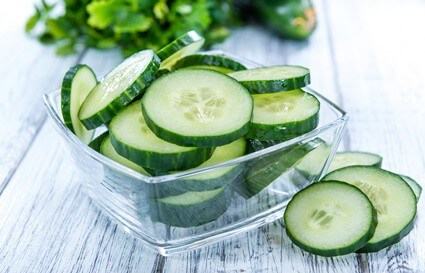
Bored with Food
If you continuously feed angelfish the same vegetables every week, they may be bored of them.
Angelfish have complex personalities and require mental stimulation, which they get as much through a varied diet as they do any other means.
This means that you’ll need to keep switching your fish’s diet up to prevent them from getting fed up with their food.
Fish flakes and pellets aren’t very exciting for them, so incorporating a range of tasty veggies each week is an excellent way to keep them happy.
Similarly, if you feed angelfish the same foods repeatedly, they’re at risk of nutritional deficiencies. Check for any symptoms that indicate your fish aren’t getting the nutrients they need.
Check For Illnesses
Illnesses and diseases, such as freshwater ich and hole-in-the-head disease, sometimes cause fish to lose their appetite. Fish won’t eat because they’re in too much pain or discomfort.
Similarly, when parasites and contagious diseases affect an angelfish, it’s unlikely to be long before the entire tank is adversely affected. This might be why you notice lots of uneaten vegetables floating in the aquarium,
Stress also causes angelfish to lose their appetite. Common symptoms include:
- Frantic swimming.
- Gasping at the surface of the tank.
- General unwellness.
- Lack of appetite.
- Odd swimming patterns.
- Red eyes.
- Refusal to eat.
- White spots on the body.
If you notice any of these signs at the same time your angelfish are refusing to eat vegetables, it’s possible that they could be suffering from a stress problem.
This is usually due to aggressive fish, poor water quality, or boredom.
While vegetables are a good source of vitamins, nutrients, and minerals for angelfish, be careful not to overfeed. This is one of the worst things you can do because they’re at risk of becoming obese.
Also, clean the tank when your fish have finished eating to prevent harmful ammonia and nitrites from affecting the water.

